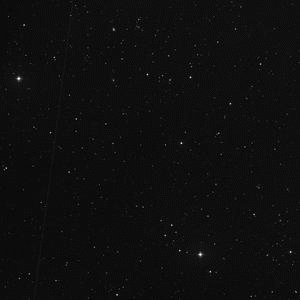IC 3166

Overlaid DSS image of IC 3166, 60' x 60' with north at top and west to the right
Aladin viewer for the region around IC 3166
| Type | Unknown |
|---|---|
| Magnitude | Right Ascension | 12h 19' 54.0" (2000) |
| Declination | 60° 41' 39" N |
| Constellation | Ursa Major |
Observing Notes
Harold Corwin
IC 3166 and IC 3180 are a pair found by Lewis Swift on 24 June 1897 during his several years observing from Echo Mountain north of Pasadena. Unfortunately, there is a large error in his positions for the nebulae as there is nothing within at least two degrees matching his descriptions:
[IC 3166]: eeeF, S, 7 1/2 and 5 mag sts in field, p of 2. One of my faintest nebulae.
[IC 3180]: vF, pL, R, 7 1/2 mag * south, f of 2.
My own guess is that Swift rediscovered NGC 4284 and NGC 4290. His RA's would be fairly close (about 20 arcsec out), but his declinations would be 2 deg, 36 arcmin off. His relative brightnesses and sizes for the galaxies are correct, but I have trouble making the star field around the NGC galaxies match his description. There is a 6th magnitude star 14 arcmin south of NGC 4290; this may be his "7 1/2 mag * south" -- but where is that 5th magnitude star? I see no trace of it. Given that, I'm not even going to be putting the IC numbers in the position table with question marks.
Similarly, Swift's nebulae could be NGC 3975 and NGC 3978. There, the Dec's are only 10.0 arcmin off, but the RA's are 24.5 minutes of time off. The two objects are closer together on the sky, though, and the problem of the star field remains. Here, there is a distinctive double star north of the galaxies, another of similar magnitude (about 10.5; I'm guessing here) west- southwest, and two brighter stars (9 and 7.5) east of the NGC objects.
I also checked that one hour or ten degree errors were not involved. Nothing east or west, north or south, fits Swift's descriptions. I did not, however, check northeast, southeast, northwest, or southwest at these digit errors.
In the end, I suspect the N4284/N4290 pair is what Swift actually saw, but ...
In March 2017, Gary Kronk did a search in an area of 20deg by 11deg centered on Swift's position for IC 3166. The closest matching field he found was that around NGC 4284 and NGC 4290. Based on his results, I've once again looked at the field and Swift's observations, but still can't make the stars match what we now see on the sky. The 6th magnitude star I mentioned earlier is 70 UMa -- the actual V is 5.5 -- and may actually be Swift's 5th magnitude star. But the brightest of the fainter stars in the field (assuming it is Swift's usual 33 arcminute field) are at V = 9.5. Even being generous with Swift's estimates, this is well below the "7 1/2 mag" that he states in his descriptions.
So, I remain skeptical. However, I have put the NGC objects into the IC position file, with double queries, as potential candidates.
For the record, Gary also suggested MCG +09-19-182 = PGC 36774 and MCG +09-19-190 = PGC 36805 as possibly being Swift's objects. These at least have two stars of approximately the correct magnitudes in the field, but the magnitudes and sizes of the galaxies of the galaxies are virtually identical. This is a clear mismatch with Swift's descriptions. Also the fainter of the stars is well to the southeast of the galaxies rather than straight south; and the brighter star is much closer to the preceding galaxy. Again, we have to stretch to match Swift's descripitions. Still a possibility, I suppose, but neither Gary nor I am convinced.
Other Data Sources for IC 3166
Nearby objects for IC 3166
Credits...
Drawings, descriptions, and CCD photos are copyright Andrew Cooper unless otherwise noted, no usage without permission.
A complete list of credits and sources can be found on the about page
IC 3166